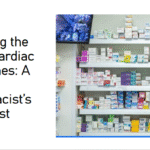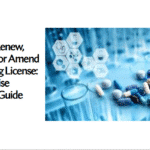Understanding Schedule H and H1 Drugs in Cardiac & Diabetic Range
Understanding both the Schedule H and H1 drugs is very important, especially for people taking them lightly. Both of these drugs are prescription medicines in India, but they are different from others. You can’t take these medicines like others, as there are some specific regulations on them. These strict regulations are related to the sale and use of these drugs. To use these drugs, you need prescriptions from registered medical professionals who are legit. The sales of these drugs must keep a strict record-keeping according to the regulations. Putting a red ‘RX’ symbol on the label of these drugs is also made mandatory by the government. These medications come in a variety that can be used both in cardiac and diabetic care.
Table of Contents
ToggleWhat are Schedule H drugs?
First, let’s understand the Schedule H drugs and their meaning in detail.
- These drugs come under the Drugs and Cosmetics Rules, where they are listed. These drugs can’t be bought without a prescription, according to the rules.
- They have a specific label called the “RX” symbol, which helps identify them.
- These medications come in a variety that can be used both in cardiac and diabetic care. This includes the availability of anti-hypertensives, lipid-lowering agents, which help in those problems. Oral hypoglycaemics are also included in these.
- If you want more examples, here they are:
- Captopril
- Metoprolol
- Glibenclamide.
- There are many possible side effects for these medicines, so using them without medical guidance is a big risk. For safety, always look for a prescription for these.
What are Schedule H1 Drugs?
Now, let’s understand the Schedule H2 Drugs and their meaning in detail.
- These drugs are known as a sub-category of Schedule H drugs with some changes in controls. These changes in the controls are stricter here.
- You may find third and fourth-generation antibiotics in here, which are included. Some anti-tuberculosis medications can also be seen with certain psychotropic drugs.
- Many people misuse and abuse these potent medications with bad intentions, which leads to these rules.
- The main purpose of Schedule H1 is to prevent those abuses from happening.
- There are many examples of these types of drugs, such as antibiotics for serious infections and more. For diabetes, there are antidiabetics, ones with some anti-anxiety ones too.
- You can have serious side effects from these medicines, so think before using them carelessly.
Conditions For Selling These Drugs
- The rule says that every sale must be recorded separately as proof. This record must contain some specific details, like the prescriber’s and the patient’s details. The name of the drug prescribed should be mentioned with the quantity supplied.
- For a minimum of 3 years, these records need to be kept safe.
- The drug label should have a warning that tells not to consume without a prescription. In addition, an “RX” symbol in red must be visible on the label of the drug.
Their Usage for Diabetic and Cardiac Care
Both the Schedule H and H1 Drugs have a range of medications for the care of diabetic and cardiac conditions. Though not all of them, some antibiotics under these do help with these problems.
- Both Schedule H and H1 have some medications to help cure issues like diabetes and cardiac-related conditions.
Cardiac Care:
- For cardiac care, many medications are there like beta-blockers and ACE inhibitors, that can help with these.
- Statins and antiplatelet agents are also most commonly prescribed for the treatment of heart issues by doctors
Diabetic Care:
- For diabetic care, many medications are used to manage the problem, which come under these categories.
- These include insulin and oral hypoglycemic agents, which control blood sugar levels to manage diabetes.
- These agents are mostly metformin and sulfonylureas that work to manage these problems in many cases
Schedule H & H1 Considerations:
- Some cardiac and diabetic medications, like antibiotics, are helpful to treat infections in patients under this.
- All of these antibiotics are classified under the Schedule H and H1 with strict prescriptions.
- All of these can only be provided with a prescription and record keeping of the same.
Overall Importance of These
Promoting Rational Drug Use:
All the regulations for these drugs may be complex, but they promote the rational use of drugs.
Misuse of these drugs may potentially be stopped with regulations.
Reducing Antibiotic Resistance:
Antibiotic resistance will be curbed with the new regulations on control.
Protecting Patient Safety:
The rule that says that these medications can only be given with a prescription is actually helpful. This will prevent people from having it directly and then later suffering from the side effects.
Conclusion
Schedule H and H1 drugs are beneficial for issues like diabetes and cardiac conditions if taken with a prescription. Many details about them are mentioned about including the regulations. Many antibiotics help with these problems and have helped many people in the past if taken carefully. Make sure to keep a record of each sale if you are a professional medical person. For patients, looking for educated medical personnel is important for prescriptions.
Frequently Asked Questions
Q- Is there a difference between Schedule H and H1 drugs?
A – Yes, the difference is the potential to abuse, which is higher in one of them. Schedule H1 drugs are more prone to it, with even more possibility of addiction.
Q- What purpose do the Schedule H1 drugs have?
A – The main primary purpose of those drugs in the country is to check for the misuse of some antibiotics. It also helps to address the issue of antimicrobial agents.
Q- Which of the drugs are for diabetes under this category?
A – These include insulin and oral hypoglycemic agents, which are used for these related issues.
Q – What happens if they get misused?
A – If that happens, side effects could be seen on the person misusing them, with antibiotic Resistance.





